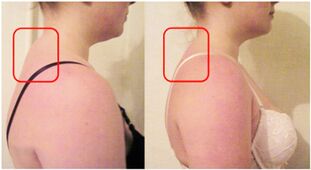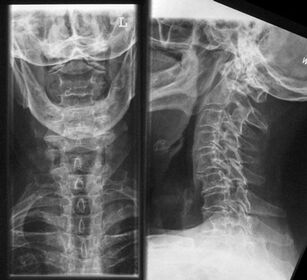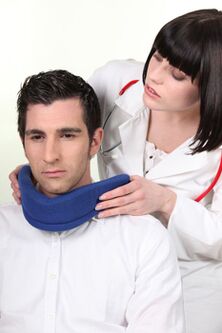
Osteochondrosis of the cervical spine is known and well studied. At the moment, a large part of the active population suffers from this disease. This type of osteochondrosis develops not only in the adult population, but is quite common in adolescents, called juvenile osteochondrosis.
The cervical region is the most mobile part of the spine, so the load in this region is very large. The disease progresses gradually, is characterized by frequent exacerbations, which can lead to a significant decrease in the patient's quality of life.
Causes of the disease
Generally, the causes of the disease are diverse and may depend on the patient's age. We will highlight the most frequent ones:
- violation of calcium-phosphorus metabolism of any etiology;
- several traumatic back injuries;
- unbalanced load on the spine (physical inactivity or, on the contrary, effect of increased load);
- diseases of the cardiovascular system;
- congenital malformations of the spine;
- change in posture, including scoliotic type;
- circulatory disorders that lead to malnutrition of the intervertebral disc;
- age-related dystrophic bone tissue disorders.

In adolescence, injuries, unbalanced physical activity (training process) are considered the main causes of the development of the disease. In older patients, the main reason is a habitual long-term position during work, a violation of the hormonal background.
Additional predisposing factors for the development of the disease can be:
- heredity; hypothermia;
- exacerbation of poorly or not fully treated osteochondrosis;
- stressful situations and overwork.
Osteochondrosis develops gradually. A person who plays sports constantly may not realize that he is susceptible to this disease.
Most of this condition occurs in people over the age of 25. Osteochondrosis of the cervical spine is characterized by the fact that the process develops from the upper sections. However, if you do not receive medical attention, the process may gradually affect the lower segments of the spine.
Symptoms of osteochondrosis of the cervical spine in adults and children
As the disease develops over the years, in many cases the process is asymptomatic. Sometimes it happens that by chance, through X-ray images, it is possible to determine the initial signs of the disease, while there will be no active complaints. It should be remembered that the older the patient, the more varied complaints he will have.
The main complaints of cervical osteochondrosis are:
- frequent headaches and dizziness;
- numbness at the fingertips and weakness in the arms;
- vegetative manifestations;
- increased blood pressure;
- discomfort with movements in the neck;
- constant or burning pains along the spine;
- frequent myositis of the neck muscles;
- posture changes;
- restrictions on head movements;
- a forced head position can also develop;
- tinnitus;
- climate dependency;
- cracks in the neck when performing movements;
- sleep disturbance.

These are the most frequently expressed symptoms that a patient may experience. Unfortunately, the process can begin to develop in adolescence, and adolescents will make similar complaints.
Most of these symptoms occur together. Osteochondrosis of the cervical spine occurs with episodes of exacerbation and remission. This is due to the effect of provocative factors on the body. We must not forget that if a similar diagnosis is made, rehabilitation therapy and a rehabilitation course should be carried out every six months to avoid an acute period.
Considering that the main reason for the development of the disease is the decrease in intervertebral disc trophism and the lack of adequate therapy, the process can end with the formation of an intervertebral hernia.
Complaints and clinical picture of the disease - photo
Vascular manifestations in the form of dizziness or headache are aggravated during the performance of elementary motor tasks (tilting or turning the head). In the set of all complaints, the patient additionally tries to assume a forced position to reduce the symptoms, which worsens the nutrition of the intervertebral disc.
It is these complaints that most often lead the patient to see a doctor. If the treatment is not carried out, the complaints intensify and are more persistent, that is, they do not go away on their own.
Pain in cervical osteochondrosis, as a rule, constant, painful, burning character. The disease can be accompanied by periodic "lumbago", which is caused by sudden movements.

An increase in blood pressure in the context of osteochondrosis causes the patient to be examined by a therapist. If adequate treatment is not carried out in a timely manner, the increase in blood pressure will become permanent, which contributes to the development of secondary hypertension. In these situations, a correctly collected anamnesis is of great importance.
When the process is located in the cervical spine, the discomfort spreads along the neck, the constant tension of the musculoskeletal system contributes to the limitation of movements and the formation of a forced head position.
Pain in cervical osteochondrosis is accompanied by decreased sensitivity. Due to constant discomfort, a muscle roll gradually forms in the shoulder region, palpating the patient feels discomfort in that region.
In addition to constant discomfort, the patient may experience acute and acute pain in the neck. The occurrence of such complaints suggests that the patient should receive complete rest to reduce pain. In some cases, the pain is so severe that the person cannot perform the simplest actions (turning his head, taking a deep breath, straightening his back). In all cases, the patient must be examined by a doctor and the diagnosis of osteochondrosis must be confirmed.
Changes in hormone levels also play a significant role in the development of cervical spine diseases. Therefore, well-chosen physical activity will reduce general clinical symptoms and relieve the patient's condition. Due to the fact that neck pain constantly bothers, secondary sleep disorders occur. It is difficult for a person to be in a comfortable position in bed, worries, which leads to psycho-emotional stress.
In addition, the patient pays attention to disturbance of sensitivity. They are described as "chills" that are felt at your fingertips. In some cases, the discomfort can be located in the entire arm and muscle strength decreases.
Diagnosis of diseases

It is quite difficult to make a diagnosis based on an exam. Basically, to clarify the diagnosis, the following activities are performed:
- complete collection of complaints;
- consultations by specialized specialists (cardiologist, endocrinologist, neurologist);
- X-ray examination of the cervical spine;
- magnetic resonance image.
Examinations by specialized doctors are necessary to exclude acute conditions from the cardiological profile and others. Excluding acute somatic pathology, one can speak of a diagnosis of osteochondrosis. In addition to general clinical manifestations, the diagnosis can be confirmed by means of an X-ray examination of the spine.
X-rays are the most accessible and easy to use test to aid in diagnosis. The image shows a narrowing of the space between the vertebrae, which indicates dystrophy of the intervertebral disc. Bone protuberances can be distinguished along the edges of the vertebrae. If osteochondrosis is complicated by instability in the cervical spine, then on radiography you can see the displacement of the vertebrae between them.
Osteochondrosis of the cervical spine is a disease that can radiographically show which area is most damaged. Even when examining a cervical segment, you can see that the process is not evenly distributed.
In especially difficult cases, MRI is performed, which helps to diagnose a complication of osteochondrosis - intervertebral hernia. Thanks to the magnetic resonance image layer by layer, it is possible to determine even the smallest hernial changes and immediately indicate the level of the lesion.
Treatment of osteochondrosis of the cervical spine

Only a doctor knows how to treat cervical osteochondrosis in the acute and interictal period. The therapy prescribed for this condition should be comprehensive. With an exacerbation of the disease, it includes:
- medications;
- complex rehabilitation therapy (physiotherapy exercises, gymnastics, massage, acupuncture, manual therapy);
- physiotherapy (electrophoresis, UHF, magnetotherapy, laser therapy);
To prevent the exacerbation of osteochondrosis, use:
- spa treatment;
- traditional medicine;
- wearing special bandages and corsets;
- changes in lifestyle (weight loss, balanced physical activity).
The drugs for the treatment of cervical spine osteochondrosis are as follows:
- anti-inflammatories;
- medicines that improve blood circulation;
- vitamin complexes;
- in acute situations, analgesics;
- means that it reduces muscle tension.
In addition to pills and injections, creams, ointments and gels are actively prescribed, which are applied to the affected area. Due to their effect, they contribute to skin irritation in a certain area, which improves blood circulation in small vessels, ensuring the delivery of nutrients to the injured segments and reducing muscle tension.

After an acute period, physiotherapy, massage and physiotherapy exercises are scheduled. Rehabilitation therapy is a complement to conventional medical treatment. As the condition improves, nutrition and trophism in the intervertebral disc also improves.
During treatment, the patient will notice an improvement in well-being, an increase in efficiency and mood. If the treatment is stopped, without completing it, the exacerbations of osteochondrosis will pass quite frequently.
How to treat cervical osteochondrosis in the recovery period will be informed by a rehabilitator. Before talking about the rehabilitation therapy complex, it should be noted that any treatment must be accompanied by the correction of bed linen. Includes orthopedic mattresses and pillows.
Experts also recommend wearing a Shants collar permanently or for a specified period of time. This method is widely used in children's practice, when patients use it during their homework period. The Shants collar is individually selected in orthopedic salons.
An orthopedic pillow for cervical osteochondrosis is selected for each patient. It must be suitable for the size of the bed and selected according to the patient's constitution. It should not be too small or too big, the main orientation is the width of the person's shoulders.
A pillow for prolonged sleep and rest should be of medium firmness and resemble a square or rectangle. Other shapes are suitable for short breaks. Depending on the activity of the degenerative process, the orthopedic pillow for cervical osteochondrosis should change.
Exercise and gymnastics (lfk)

Rehabilitation therapy should include gymnastics. The main task of the exercises is to strengthen the neck and back muscles, the upper shoulder girdle, improve the mobility of the spine and eliminate the muscle clamps. In addition, exercises for cervical osteochondrosis affect deeply located muscles.
As a result of gymnastics in cervical osteochondrosis, the physiological curves are gradually restored and the load on the intervertebral discs decreases. We must not forget that the exercises for cervical osteochondrosis must also include the thoracic segments.
Gymnastics for cervical osteochondrosis are performed with an instructor. Helps patients understand which areas need to be emphasized the most. The load and volume of the tasks are selected individually and depends on:
- the patient's age;
- on the prevalence of the process;
- for the presence of additional comorbidities;
- on the effectiveness of drug therapy.
At the beginning, they perform simple and not difficult tasks, as the body begins to adapt to the new conditions and the muscles do their work in sufficient volume, the exercises become more difficult and the duration of the sessions increases.
Exercise therapy for cervical osteochondrosis includes simple actions. These are tilting the head back and forth, gradually adding circular movements of the head. It must be kept in mind that even for physical therapy exercises there may be contraindications. As a rule, the complex of a lesson includes tasks that aim to develop and influence all segments of the spine.
After exercises on the cervical spine, tasks are added gradually to improve the work of the thoracic and lumbar spine. Physical therapy exercises for cervical osteochondrosis can be performed standing or sitting. The tasks are performed gradually, at a slow pace, which will allow for additional breathing exercises.
Contraindications for physiotherapy exercises:
- acute pain syndrome;
- increase in blood pressure and presence of cardiac pathology in the acute phase;
- coordination disorders and diseases of the vestibular apparatus;
- temperature increase;
- exacerbation of another chronic pathology;
- status after surgical treatment.
Special technique exercises
This technique is based on the phased restoration of normal activity of the musculoskeletal system. The gymnastic exercises, carried out in a specialized simulator, allow to gradually restore the work of the structures of the cervical spine.
First, pain is relieved, then blood circulation is restored, muscle tension is removed, and classes are conducted to expand motor activity in the cervical spine. The method is additionally supported by massage courses, classes at the pool.

Massage for cervical spine osteochondrosis
In addition to general strengthening exercises, massage has a very good effect. The massage for cervical osteochondrosis can be used in different ways (classical, segmental, punctual). In some cases, a combination of different techniques in one session is allowed.
We cannot forget that the massage for cervical osteochondrosis is performed on a hard surface, face down, and its duration can vary from ten sessions or more. The frequency of repetition of the course is also determined by the attending physician. The effectiveness of the massage will last longer if the patient sleeps on the correct pillow.
Physiotherapy procedures, such as magnetism or electrophoresis, have a local irritating effect. Magnetotherapy is a painless procedure and well tolerated by adults and children. The manipulation lasts several minutes, the patient must remain lying down, therefore, it is more often recommended for older patients.
Electrophoresis is a manipulation that is performed with a special device. During the procedure, the patient feels a slight tingling sensation generated by the currents. The frequency and impulsivity of the signal are different for each age. This technique is used to inject a medicinal substance that has a positive effect. This manipulation is more aggressive compared to magnetotherapy, so there must be strict indications for its application.
This technique is used to inject a medicinal substance that has a positive effect. This manipulation is more aggressive compared to magnetotherapy, so there must be strict indications for its application.
A balanced diet is essential for this disease. Patients are advised to eat fruits, vegetables, meat, herbs, fish. You should limit your consumption of salt and all kinds of spices, seasonings, smoked or fried foods, sugar. It is best to take herbal teas and decoctions, it is advisable to avoid drinking coffee and alcoholic beverages.
Traditional medicine is used to reduce pain. Most often, compresses and mixtures are used, which are applied to the affected area. Success in the treatment of osteochondrosis of the cervical spine depends a lot on the patient's conscience. You shouldn't stop starting classes and therapy as soon as you feel better. It is irrational to constantly use painkillers that bring temporary relief, and the disease itself is not treated.




























